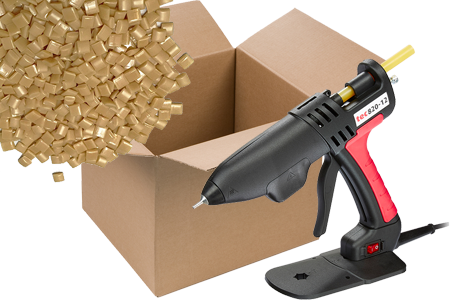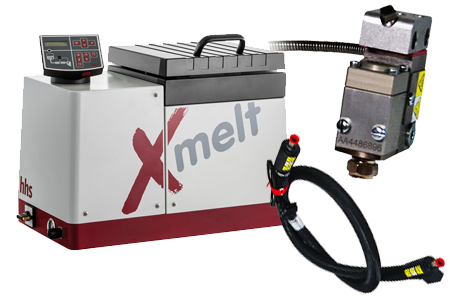December 18, 2024
Adhesives play a vital role in many applications and are continuing to grow in their use. Both efficient and aesthetically pleasing, they can be used for everything from producing a secure bond to prevent packaging pop-opens to creating a clean look on a manufactured product. While adhesives are great for many reasons, they can also lead to some problems if applied incorrectly. One common issue is hot melt glue stringing.
What is Hot Melt Glue Stringing?

Hot melt glue stringing, also sometimes called angel hair, is small, thread-like glue residue that is left behind during the application process. Adhesive stringing occurs when the adhesive does not cleanly separate from the nozzle. Instead, a small amount of glue gets pulled between the substrate and the applicator to create a thin string. Hot melt stringing can vary in thickness and length depending on the application process.
Stringing in hot melt packaging and manufacturing applications is common. Not only is it messy and unsightly, but hot melt adhesive stringing may also cause production delays, downtime, and sometimes defects in the finished product. On top of that, each string is wasted adhesive (and money) for your business.
Causes of Adhesive Stringing
The first step to solving hot melt glue stringing issues is determining the cause. There are several different causes of adhesive stringing such as:
- The temperature is wrong. The right temperature is imperative for proper use. If the temperature of the applicator is too low, the adhesive can become too viscous and lead to more adhesive stringing. Conversely if the adhesive is too hot, it may be runny and also lead to stringing in hot melt adhesives.
- The adhesive needs replacing. Adhesives with a high viscosity can lead to more residue left behind and are more likely to string. Similarly, a hot melt that is too tacky will be sticky and may lead to excessive stinging. In other cases, the type of adhesive is fine, but degradation has occurred.
- The substrate is too far away. The farther an adhesive has to go to reach the substrate, the more likely adhesive stringing will occur.
- The nozzle shut-off is not working. Poor nozzle shut-off can lead to residual adhesive that can start to string.
- There is too much airflow. Excessive airflow in the application environment, such as nearby fans or HVAC circulation, can decrease the air temperature and lead to faster set times and consequently stringing of the adhesive.
How to Prevent Hot Melt Glue Stringing
While hot melt stringing is a common problem with many causes, it is often preventable. If you are experiencing this issue, some potential solutions to stop hot melt glue stringing include:
- Checking Your Equipment: One of the first steps to stopping adhesive stringing is to check your equipment settings. The temperature should be within the recommended temperature range, but you may want to consider adjusting the temperature slightly to see if it fixes your problem. You should also check the application nozzle to ensure the shut-off is working properly and there is no adhesive charring. Move the applicator closer to the substrate if possible and always perform regular maintenance. If you need help with your equipment maintenance, check out our Vantage program.
- Evaluating Your Environment: Your production environment could be unknowingly contributing to the stringing of your hot melt adhesive. Check the temperature, airflow, and humidity as all can impact how your adhesive works. Make sure the environment matches that recommended by the manufacturer and make adjustments as needed.
- Changing Adhesives: If hot melt adhesive stringing continues despite adjustments to your equipment and production environment, consider changing the adhesive. One that has a lower viscosity or is less tacky may do the trick. There are also some adhesives that are specifically designed to reduce hot melt glue stringing. Always test the new adhesive before rolling it out to your entire line. If you need help determining which adhesive to use, get a product recommendation.
Stop Hot Melt Glue Stringing
Do not let hot melt adhesive stringing slow down your production or continue to waste your company's money. If you are not sure which solution is right for you or feel like you've already tried everything, contact us. Our team has several years of experience in the adhesives industry and has heard many stories of hot melt stringing problems.
Not only can we offer guidance, but also we may even be able to come out and fix the problem. Our adhesive technical services include on-site and phone appointments to evaluate your product lines and provide data-driven solutions. Request your technical consultation today.











